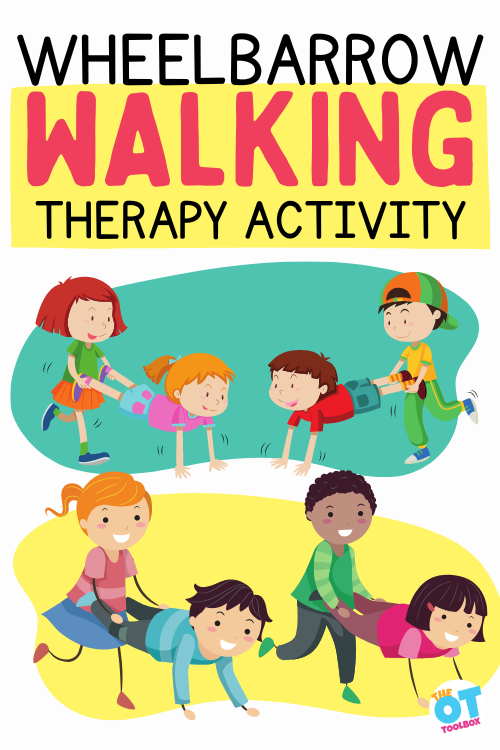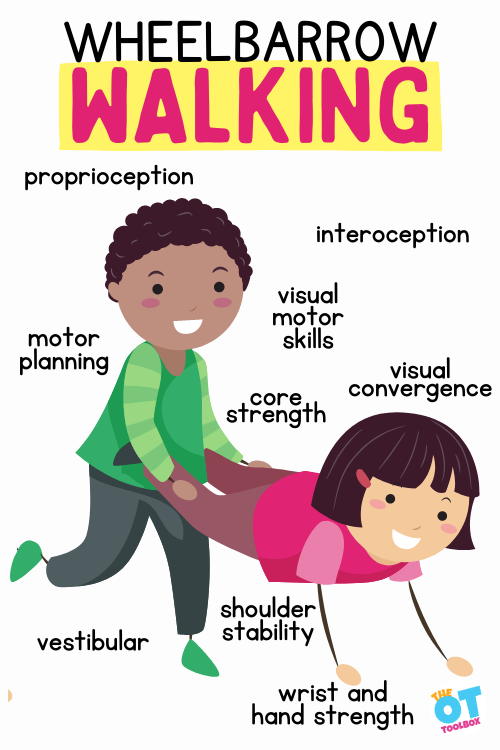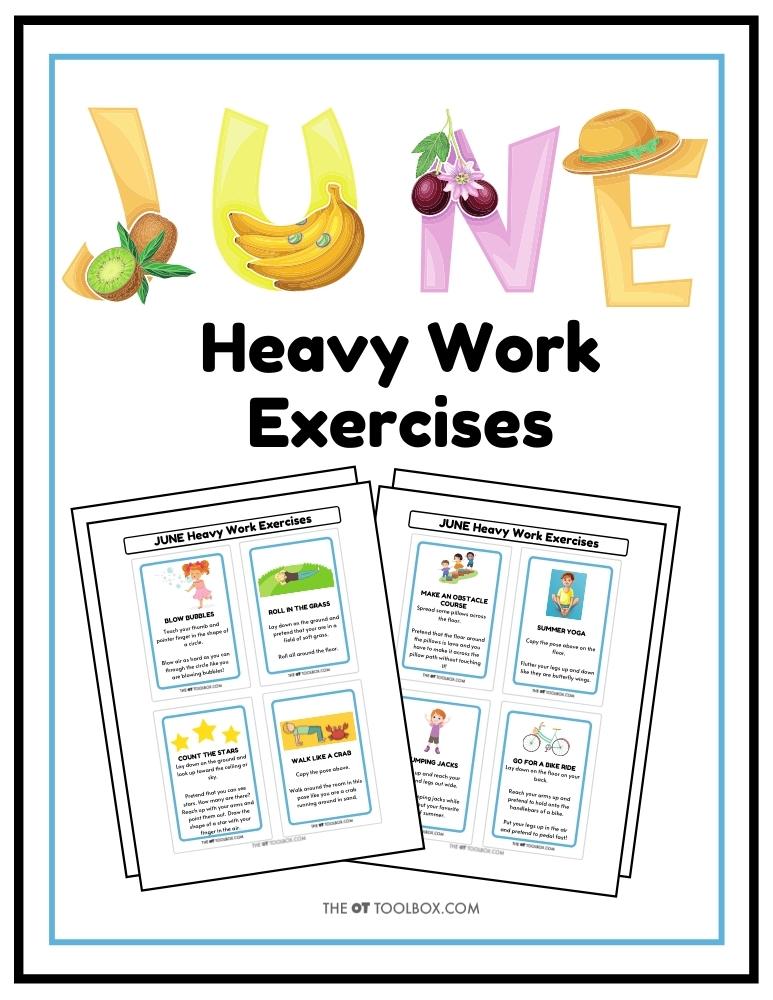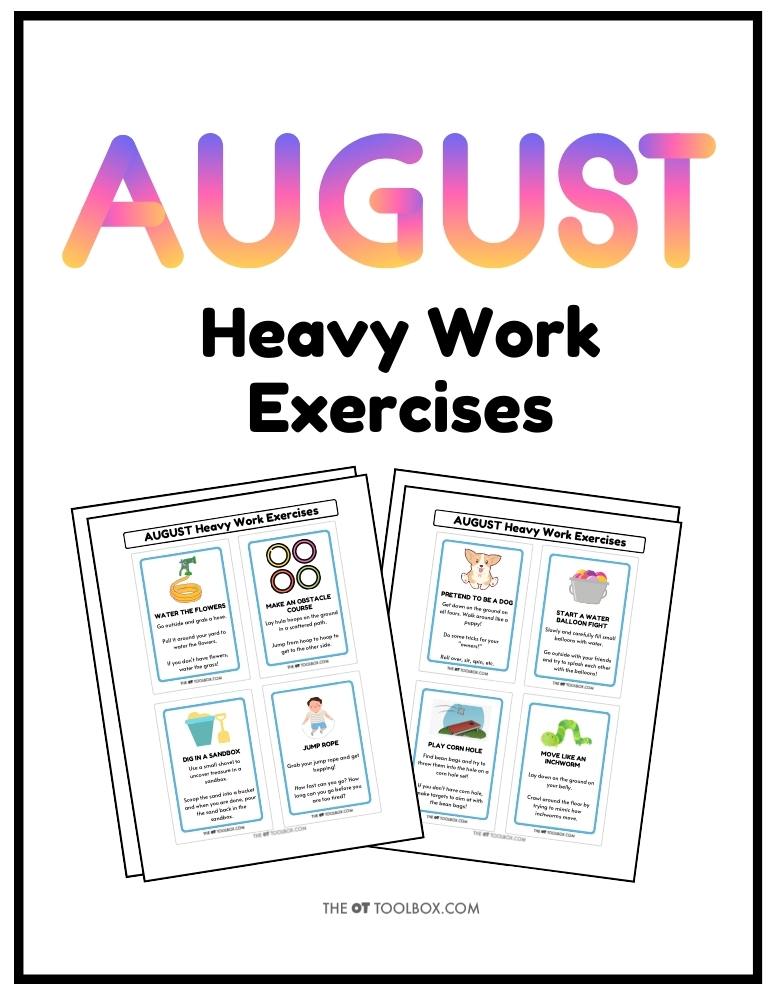Raise your hand if you have a permanent back ache from wheelbarrow walking with your children or clients? In this post you can discover how to do wheelbarrow walking, the benefits of this gross motor coordination activity, and some more ergonomic methods to save your back. Let’s get started with wheelbarrow walking for occupational therapy!

Amazon affiliate links are included in this blog post. As an Amazon Influencer, I earn from qualifying purchases.
What is Wheelbarrow Walking?
Wheelbarrow walking is (or used to be) a classic game parents play with their children, or peers engage in. For parents, this was a means to wear your kids out.
We didn’t really think of the benefits of wheelbarrow walking, just that it would hopefully produce a nap later on.
Therapists, of course, focus on the benefits of wheelbarrow walking, otherwise they would not ruin their back just for fun.

the benefits of wheelbarrow walking
I already mentioned the aching back as a drawback to this great activity, but what are the benefits?
- Proprioception: this is the information translated from the muscles and joints to the brain. Wheelbarrow walking improves regulation and awareness of this system with the pressure on the hands
- Vestibular: movement in the inner ear is definitely happening while wheelbarrow walking! The head is down or up at an angle, while the body is moving forward. This can improve vestibular awareness and regulate this important system
- Bilateral coordination: each arm is doing the same motion, but at different times. It takes a fair amount of coordination to make these movements happen smoothly
- Motor planning – the body and brain receives feedback, or a motor concept that tells the brain and body that we have moved in a certain way in order to accomplish a specific action. This is the motor plan for wheelbarrow walking at work!
- Strength and endurance – core strength, shoulder and wrist stability, head control, balance, and hand strength are all needed for wheelbarrow walking. If you see your client supporting themselves on their closed fists instead of open palms they are trying to use their shoulders instead of wrist strength. This can be considered cheating, or compensation for lack of strength.
- Executive function, following directions, attention, focus, sequencing, planning, task completion, impulse control, compliance, behavior, and work tolerance are all important skills to learn
- Teamwork and trust: you need both in order to complete wheelbarrow walking effectively. Imagine the amount of trust involved in being placed almost upside down while someone holds onto your legs. Many people find this restraining and fight the process. Both members of the wheelbarrow team have to work together to make this activity a success.
- Visual Convergence– Moving across the room toward a target requires the eyes to simultaneously move and focus both eyes together in an adducted position toward an object. With visual convergence, the eyes work together to shift inward toward a target object, with single vision occurring with fixation on the object.
- Interoception– Moving the body in an activity like wheelbarrow walking offers opportunities to determine how the movement makes the body feel. Ask the child: Do you feel tired? How do your muscles feel after doing this task? Do you feel pressure on different areas of your body when you do a wheelbarrow walk?
how to do wheelbarrow walking
The essence of wheelbarrow walking is: the body is positioned to look like a wheelbarrow. You need two people for wheelbarrow walking, and there are benefits to both individuals, making this a great group OT activity!
Person number one puts their outstretched arms on the floor in front of them.
Person number two lifts person number one’s legs high off of the ground.
Ideally the body of the person being “pushed like a wheelbarrow” is straight, at about a 45 degree angle, with the arms/hands supporting the upper body. The arms/hands represent the wheel of the barrow, while the feet represent the handles. Poor person number two is schlepping the heavy wheelbarrow to the destination and back.
While the person being pushed like a wheelbarrow is gaining upper body strength and sensory benefits, there are benefits to the person pushing and driving the wheelbarrow, too! You’ll see core strength, upper body strength, shoulder, forearm, wrist stability, and hand strength. Added benefits include motor planning and visual skills needed to maneuver the wheelbarrow walker around.
Here is a YouTube video to demonstrate wheelbarrow walking, if you are more of a visual learner.
games to play while wheelbarrow walking
Because of the general nature of children, adding a play element to wheelbarrow walking is going to garner more success than rote practice back and forth across the carpet.
The back and forth activity involved in many of these games, improves skills while definitely giving an endpoint. Some kids need to know how many times they are going to do something before they are finished.
The occupation of a child is play, so go for it!
- Puzzle game – have students wheelbarrow walk across a designated area to pick up a puzzle piece. They place it in their pocket and wheelbarrow walk back to the puzzle. The act of placing the puzzle pieces in the pocket and the puzzle gives students a much needed break between trials.
- Bean bag game – put small bean bags around the room. The student has to wheelbarrow walk toward one of the beanbags. They place the beanbag on the back of their neck and wheelbarrow walk to a basket in the middle of the room
- Farmer game – students use play food, or beanbags as the crops. Put the crop on the student’s back and have them deliver it to the market
- Obstacle course – set up an obstacle course with pillows, cones, ramps, hula hoops, tables. Create a path to navigate. Going around, up, and over obstacles makes this challenge more difficult
- Spot the dot – use circle dots, tape, or other items to mark a trail on the floor. Students wheelbarrow walk along the trail, placing one hand on each spot
- Cars to the garage, food to the stuffed bear, shapes to the sorter – use these different ideas to gather an item and bring it to a destination.
how to modify wheelbarrow walking
There are different ways to modify wheelbarrow walking to make it easier or more challenging. Some of them might even save your back!
- Wheelbarrow “walk” over a ball – use a therapy ball to support the legs. Students either support themselves like this while working on a fine motor task in front of them, or they can walk the ball forward and back with their legs. You can also use a therapy log or roll.
- Vary the grip on student’s legs – holding the student’s by the feet is the hardest variation of wheelbarrow walking. As you move your hands toward their hips you reduce the weight load on the student’s arms. While it is true you might be holding more weight in the legs, it seems less weight as you are supporting a good bit of the torso by moving toward the hips
- Wheelbarrow over the edge of the bed – use a mat table, bed, or other stable surface to hold the torso while your learner supports themselves on their arms
- Sitting on a rolling stool/chair – in order to save your back, position yourself on a rolling tool or chair on wheels. Essentially the chair or stool supports the learner’s heavy weight instead of your aching back.
other activities to build strength and coordination
- Crab or other animal walks
- This Animal Exercises Games set is a fun way to play.
- Monkey bars or hanging from a trapeze swing.
- Use these Jungle Animal Heavy Work activities.
- Traditional push ups, triceps dips, burpees, plank. Kids of Steel has body workouts for kids.
- Our sensory paths and sensory stations have fun themed activities using wall push-ups to grade the strengthening. These are all free downloads.
- The OT Toolbox has you covered with information about Upper Body Strength
- The folks at (Amazon affiliate link) Super Duper (affiliate link) have a nifty fun deck with 52 double-sided 3″ x 5″ cards teach controlled use and stability of trunk, shoulders, elbows, wrists, hands, and fingers. Content/Game idea cards. Tin box.
a final thought
Whether you are looking for an indoor activity to do during the cold or rainy weather, or some great outdoor fun, wheelbarrow walk games are a classic for building a multitude of skills. I still remember my aching muscles after wheelbarrow walking for what felt like hours.

Victoria Wood, OTR/L is a contributor to The OT Toolbox and has been providing Occupational Therapy treatment in pediatrics for more than 25 years. She has practiced in hospital settings (inpatient, outpatient, NICU, PICU), school systems, and outpatient clinics in several states. She has treated hundreds of children with various sensory processing dysfunction in the areas of behavior, gross/fine motor skills, social skills and self-care. Ms. Wood has also been a featured speaker at seminars, webinars, and school staff development training. She is the author of Seeing your Home and Community with Sensory Eyes.
Looking for more ways to support strength through sensory motor play? Our year of heavy work activity cards do just that! Print off the cards and use them as brain breaks, exercise routines, as part of therapy sessions, and at home or in the classroom.



Grab a copy of the Summer brain breaks and heavy work activities:
Each set includes brain breaks, pretend play prompts, exercises, and sensory motor tasks with a Summer theme.






